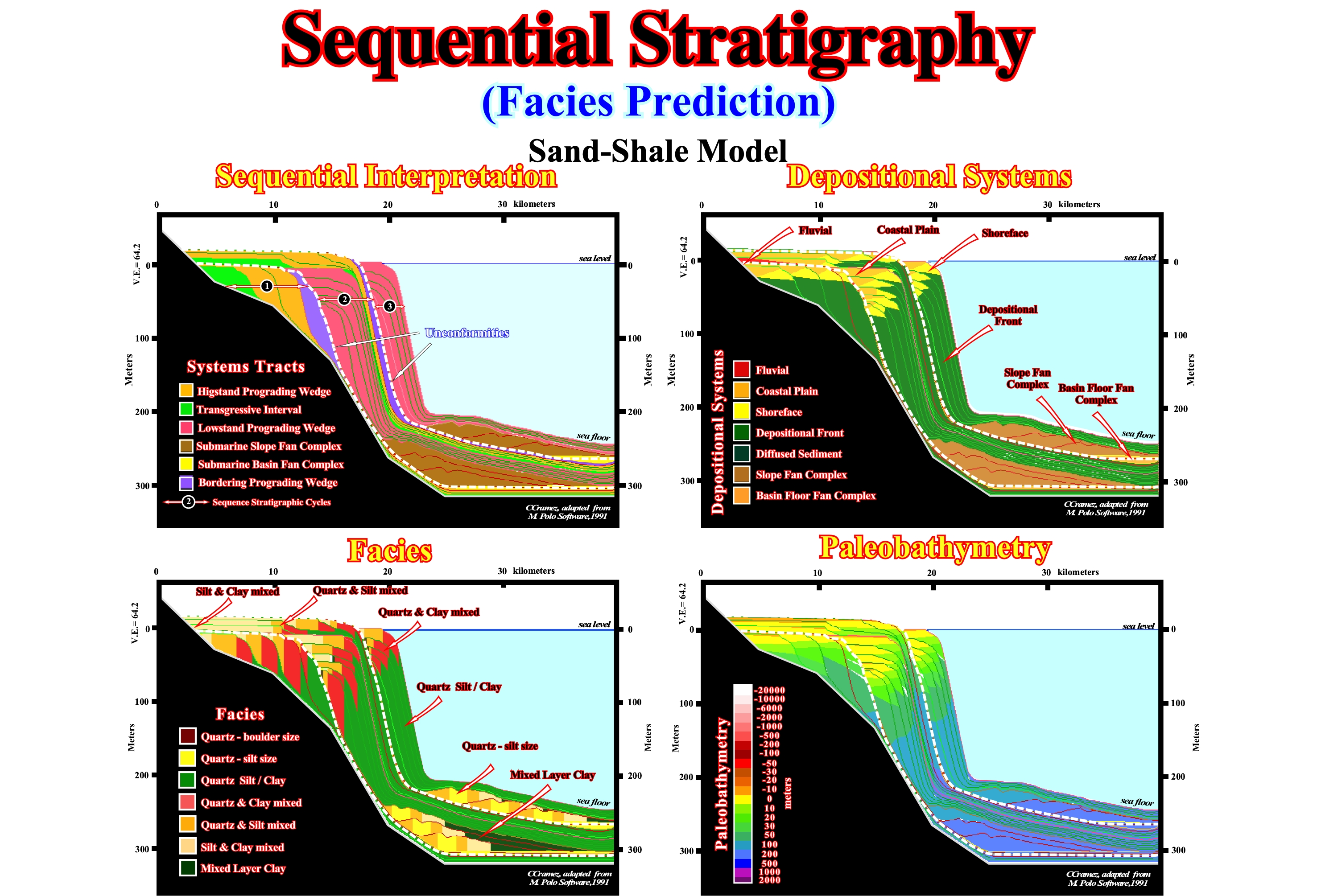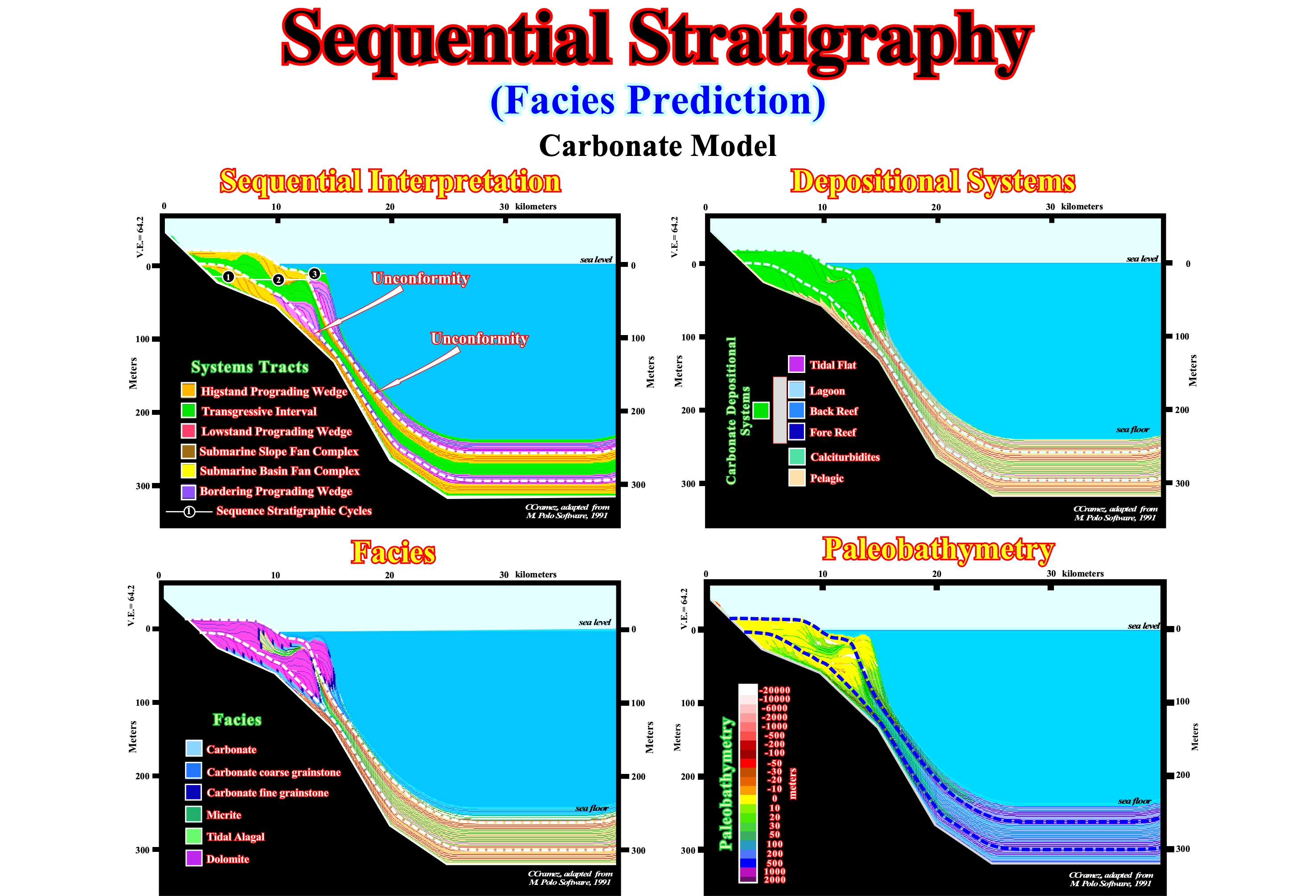

17) Facies Prediction (Depositional Systems Tracts)
Lithological predictions can just be made on tentative geological interpretations of seismic lines made at the highest hierarchical level, i.e., at the sequence-paracycle level, in which the different depositional systems tracts and depositional systems are recognized.
Every time that a geoscientist, looking at a clean seismic line (uninterpreted line) or at a seismic line interpreted in continuity, i.e., when the geoscientist just picks, in continuity, the high amplitude chronostratigraphic lines, points a given seismic reflector saying : “these sandstones are potential reservoir-rocks” or “these limestones are the reservoir-rocks” he is, probably, joking or, what is more frequent, he is not a geoscientist, but, just, a petroleum exploration functionary.

Figure 074- The sequential stratigraphy of a mathematical geological model lasting between 3.0 - 0.0 Ma, put in evidence three stratigraphic sequence-cycles (upper sketch left). The oldest (chronostratigraphic intervals 1 to 4) is incomplete. From bottom to top, we recognize just the Transgressive Systems Tracts (TST, in green color), the Highstand Systems Tracts HST (in brown) and a SMW (shelf margin wedge, in violet). The second sequence-cycle (chronostratigraphic intervals between 5 and 20) is complete. It is composed of a Lowstand Systems Tract (LST) composed by three members : (i) Basin Floor Fan (BFF) ; (ii) Slope fan (SF) and (iii) Lowstand Prograding Wedge (LPW) +SF+LPW), a Transgressive Systems Tract and Highstand Systems tracts (HST). The third sequence-cycle (chronostratigraphic lines between 21 and 30), which is not yet finished, is just represented by a LST (lowstand systems tract). As each systems tract corresponds to a lateral linkage of coeval depositional systems, i.e., coeval facies, environmental and lithological predictions can be advanced. As illustrated, in this sand-shale mathematical model, the following depositional environments can be predicted : (a) Fluvial (relating or occurring in a river, generally landward of the bay-line) ; (ii) Coastal Plain (extending along a coast) ; (iii) Shore-face (along the narrow, steeply sloping zone between the seaward limit of the shore at low water and the nearly horizontal offshore zone) ; (iv) Depositional Front (slope, seaward of the horizontal offshore zone) and (v) Deep water (turbiditic deposits). Systems tracts are composed of lateral assemblages of depositional systems, which are characterized by typical lithologies and depositional environments. On seismic data and particularly in absence of amplitude and sedimentary anomalies, the recognition of sequence-cycles and associated systems tracts, is the best way to hypothesis the most likely location of potential reservoir-rocks. The more likely potential marine source-rocks are associated to downlap surface separating transgressive systems tracts from the overlying highstand systems tracts. On the other hand, as depicted above the more likely sandy reservoir-rocks onlap against the basal unconformity bounding a sequence-cycle. The paleobathymetry, that is to say, the depositional water depth can be easily calculated, assuming that landward of the depositional coastal break, the paleowater depth is more or less zero, the coastal plain can be taken as a datum plane. Therefore, at a given point, the depositional water depth corresponds to the depth of the point in relation to the coastal datum plane depositional water depth in the platform ranges from zero to, more or less, 200 meters.
In fact, as illustrated above (figure 074) there is just one way to prognosticate the lithology on seismic lines. The seismic lines must be tentatively interpreted in terms of sequential stratigraphy. The tentative interpretation must be done a decreasing hierarchical order of the stratigraphic cycles :
A) Continental Encroachment Cycles ;
B) Continental Encroachments Subcycles ;
C) Sequence-Cycles ;
D) Paracycles of a Sequence-Cycle.
Arriving to hierarchical level33 of the sequence-cycles, the geoscientist can put in evidence the different depositional systems tracts (lowstand systems tracts, transgressive systems tracts and highstand systems tract) and so the different lithologies (figure 59) than compose a tract, since each depositional system composing a tract is characterized by a typical lithology with a typical fauna associated, i.e., a typical facies34 as defined, in 1837, by Armanz Gressly.
33The relativity of hierarchies, known as Janus dualism, it is an important feature in a sequential interpretation approach : (i) Geoscientists progress from the general to the particular ; (ii) Geoscientists cannot study geological events in isolation ; (iii) Geological structures, as well as biological structures, are multilevelled ; (iv) Each of them forms a whole with respect to its parts, while, at the same time, they are a part of a larger whole ; (v) Geological structures, and particularly stratigraphic intervals, have a hierarchical nature, which implies different levels of stratigraphic interpretations.
34Facies has a descriptive sense and serves to characterize a lithologic level, rock or mineral. American geoscientists use, often, facies to characterize an environment. They say, for instance, “These rocks are sandstones deposited a deltaic facies”, while the European geoscientist, following Gressly, say “These rocks with a sandstone facies were deposited in a deltaic environment”.
In a carbonate model, the methodological approach is the same. Using the same geological parameter, just replacing the terrigeneous influx by a carbonate production curve (in function of the water-depth) the geometrical relationships between the chronostratigraphic lines are the same to those recognized in a sand-shale model, as illustrated in figure 74. Their recognition requires just few minutes of attention, is just a question of habitude and practice.

Figure 075- the model response, when the terrigeneous influx is replaced by a carbonate function, is quite different from the sand-shale response. Reef buildups develop near the shelf break. On the contrary, in deep water, the geometry of the chronostratigraphic is here more or less parallel (pelagic limestones). The sequential stratigraphy of the carbonate model strongly suggests that the lowstand systems tracts (LPW, SF and BFF) are, often absent. On the contrary, the shelf margins wedge (SMW) is more developed than in the sand-shale model, as well as the transgressive systems tracts (TST). In a carbonate model, the prediction of depositional environments is much more difficult than in the sand-shale model. We prefer to give just a rough idea of the limit between the pelagic sediments and the carbonate depositional systems, knowing that in such a term we include (i) lagoon, (ii) back reef and (iii) fore reef. The software used here (Marco Polo) does not work so well as in the sand-shale model. As for the depositional environments, facies prediction is also very speculative. The results of the model have been refuted several times. Using the geometry of the chronostratigraphic lines and the sequential stratigraphy, the above paleobathymetry can be predicted. It strongly depends on the carbonate function used in the model.
Depositional systems as (i) Tidal flat ; (ii) Lagoon ; (iii) Backreef ; (iv) Forereef ; (v) Calciturbidites and Pelagic can be found on the different systems tracts, but its individualization is highly speculative. The same is true for the facies, which the more common are ; (a) Carbonate ; (b) Carbonate coarse grainstone ; (c) Carbonate fine grainstone ; (d) Micrite ; (e) Tidal Algal ; (f) Dolomite, etc.
In conclusion : In spite the fact that any lithologic prediction requires a scientific approach and not just a guess, it must be said that in sand-shale depocenters, they are relatively easy using a sequential stratigraphic analysis (the depositional systems composing the systems tracts are relatively simples and easy to recognize), what is not the case for the carbonate depocenters, in which the depositional systems and facies are much more complexes.